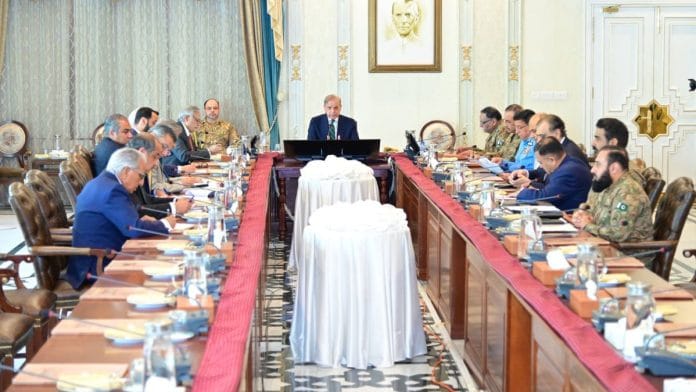“Pakistan shall exercise the right to hold all bilateral agreements with India including but not limited to Simla Agreement in abeyance, till India desists from its manifested behaviour of fomenting terrorism inside Pakistan; trans-national killings; and non-adherence to international law and UN Resolutions on Kashmir,” the Pakistan Prime Minister’s Office said in a statement.
The move by Pakistan follows a meeting of the National Security Committee convened by Prime Minister Shehbaz Sharif earlier Thursday. On Wednesday, India announced cross-border links in the terrorist attack in Pahalgam, which left 25 Indians and one foreign national dead.
The attack was carried out by four gunmen armed with AK-47 rifles affiliated with Lashkar-e-Taiba (LeT), as reported by ThePrint earlier. India’s Cabinet Committee on Security (CCS) took five decisions Wednesday as a part of its diplomatic retaliation to the attacks. Apart from the expulsion and annulment of the posts of three defence advisers in the Pakistan High Commission in New Delhi, India had also announced that it is holding the Indus Water Treaty in “abeyance”.
Also Read: Pahalgam terror attack: J&K Police releases names of 3 LeT terrorists, 2 from Pakistan, 1 Kashmiri
Understanding the Simla Agreement
The Simla Agreement, signed on 2 July 1972 between then Indian prime minister Indira Gandhi and Pakistani president Zulfikar Ali Bhutto, was aimed at bringing the then 25-year-old conflict between the two countries to an end.
It was signed after the creation of Bangladesh during the 1971 Liberation War and set the stage for subsequent agreements that led to the repatriation of citizens between Pakistan and Bangladesh, as well as the repatriation of Prisoners of War (PoWs). This eventually culminated in Islamabad recognising Dhaka as an independent and sovereign nation in February 1974.
The Simla Agreement attempted to set the stage for better ties between India and Pakistan, including the resumption of postal links, communications, sea and land border posts and even air links. The two main outcomes of the agreement, however, lies in the recognition of the LoC as the de facto position of both nations and the consensus revolving around solving all issues between New Delhi and Islamabad bilaterally, rather than through multilateral forums.
“In Jammu and Kashmir, the line of control resulting from the cease-fire of 17 December 1971 shall be respected by both sides without prejudice to the recognised position of either side. Neither side shall seek to alter it unilaterally, irrespective of mutual differences and legal interpretations. Both sides further undertake to refrain from the threat or the use of force in violation of this Line,” clause 4 (ii) of the agreement says.
Since the establishment of the LoC at Simla in 1972, it has remained as the accepted military position for the respective armed forces of India and Pakistan. While there have been a number of conflicts and skirmishes, including Siachen Glacier in 1984, and also witnessed the Kargil War in 1999, between New Delhi and Islamabad since, the LoC has endured.
Nevertheless, Islamabad has threatened to hold the Agreement in “abeyance”.
The LoC replaced the earlier ceasefire line, which the two countries agreed to at Karachi in 1949 under the supervision of the United Nations. The UN had at the time directed the United Nations Military Observer Group in India and Pakistan (UNMOGIP) to observe and report on the ceasefire line.
However, the Simla Agreement, according to New Delhi, ended the mandate of the UNMOGIP, given that the two countries had demarcated the LoC.
This is the other significance stemming from the establishment of the LoC. For India it terminated the UN’s role in observing the military line, given that it was no longer the ceasefire line stemming from the Karachi Agreement, but rather a military line established by a bilateral agreement.
On the resolution of issues
The other important portion of the Simla Agreement is on the resolution of any issues between the two countries. It says that “the two countries are resolved to settle their differences by peaceful means through bilateral negotiations or by any other peaceful means mutually agreed upon between them.”
India has maintained that the Simla Agreement ensures that all issues between New Delhi and Islamabad will be resolved through bilateral negotiations. This has seen India in the past reject calls for any third-party attempt to mediate issues.
Apart from the Simla Agreement, Pakistan’s move could put a number of other existing agreements in “abeyance”, including the protocol to allow visits of religious shrines by communities from either country and the agreement on the prohibition of attack against nuclear installations and facilities. It was not immediately what other agreements Pakistan was referring to.
The agreement also finds mention in the Lahore Declaration, agreed to by former PMs Atal Bihari Vajpayee and Nawaz Sharif in February 1999. The two countries “reiterated” their determination to implement the Simla Agreement at the time.
(Edited by Sanya Mathur)
Also Read:Canada condemns Pahalgam terror attack nearly 30 hours later, last G7 country to do so






